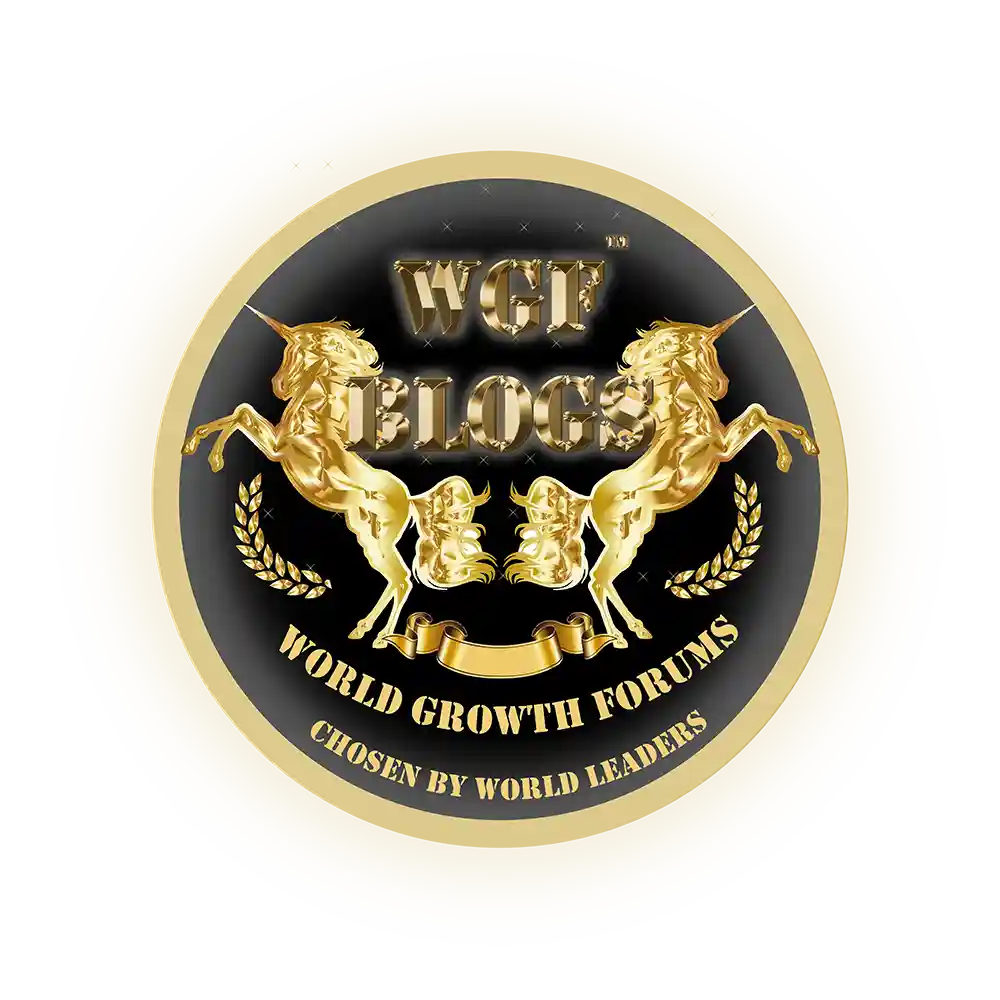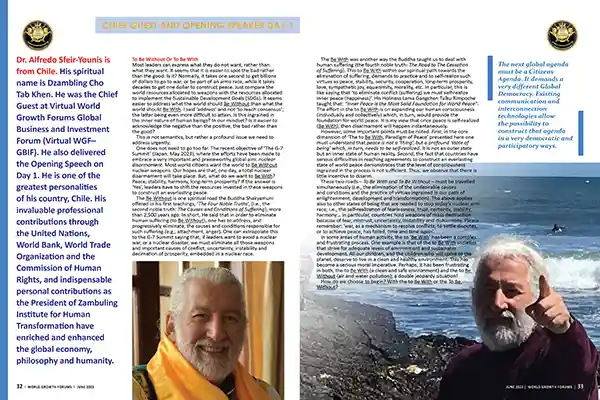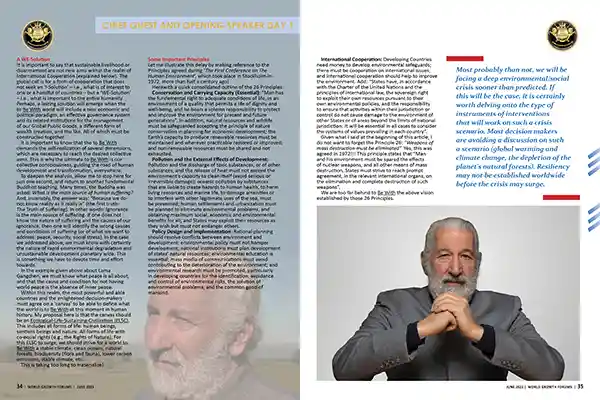
Dr Alfredo Sfeir-Younis,
Presidential Candidate of Chile,
Former Director of the World Bank,
Special Representative of the United Nations
WGF World’s Top Nation Builders

World Growth Forums Magazine June 2023
WGF Virtual Global Business and Investment Forum
What World Do You Want? One ‘With’ Or One ‘Without’?

By Dr Alfredo Sfeir-Younis
Presidential Candidate of Chile,
Former Director of the World Bank,
Special Representative of the United Nations
Dr. Alfredo Sfeir-Younis is from Chile. His spiritual name is Dzambling Cho Tab Khen. He was the Chief Guest at Virtual World Growth Forums Global Business and Investment Forum (Virtual WGF–GBIF). He also delivered the Opening Speech on Day 1. He is one of the greatest personalities of his country, Chile. His invaluable professional contributions through the United Nations, World Bank, World Trade Organization and the Commission of Human Rights, and indispensable personal contributions as the President of Zambuling Institute for Human Transformation have enriched and enhanced the global economy, philosophy and humanity.
To Be Without Or To Be With
Most leaders can express what they do not want, rather than what they want. It seems that it is easier to spot the bad rather than the good. Is it? Normally, it takes one second to get billions of dollars to go to war, or be part of an arms race, while it takes decades to get one dollar to construct peace. Just compare the world resources allocated to weapons with the resources allocated to implement the Sustainable Development Goals (SDGs). It seems easier to address what the world should Be Without than what the world should Be With. I said ‘address’ and not ‘to reach consensus’; the latter being even more difficult to attain. Is this ingrained in the inner nature of human beings? In our mindset? Is it easier to acknowledge the negative than the positive, the bad rather than the good?
This is not semantics, but rather a profound issue we need to address urgently.
One does not need to go too far. The recent objective of ‘The G-7 Summit’ (Japan, May 2023), where the efforts have been made to embrace a very important and praiseworthy global aim: nuclear disarmament. Most world citizens want the world to Be Without nuclear weapons. Our hopes are that, one day, a total nuclear disarmament will take place. But, what do we want to Be With? Peace, stability, harmony, long-term prosperity? If the answer is ‘Yes’, leaders have to shift the resources invested in these weapons to construct an everlasting peace.
The Be Without is one spiritual road the Buddha Shakyamuni offered in his first teachings, ‘The Four Noble Truths’, (i.e., the second noble truth: The Causes and Conditions of Suffering), more than 2,500 years ago. In short, He said that in order to eliminate human suffering (to Be Without), one has to address, and progressively eliminate, the causes and conditions responsible for such suffering (e.g., attachment, anger). One can extrapolate this to the G-7 Summit saying that, if leaders want to avoid a nuclear war, or a nuclear disaster, we must eliminate all those weapons and important causes of conflict, uncertainty, instability and decimation of prosperity, embedded in a nuclear race.
The next global agenda must be a Citizens Agenda. It demands a very different Global Democracy. Existing communication and interconnection technologies allow the possibility to construct that agenda in a very democratic and participatory ways.
The Be With was another way the Buddha taught us to deal with human suffering (the fourth noble truth: The Road to The Cessation of Suffering). This to Be With within our spiritual path towards the elimination of suffering, demands to practice and to self-realize such virtues as peace, stability, security, cooperation, long-term prosperity, love, sympathetic joy, equanimity, morality, etc. In particular, this is like saying that ‘to eliminate conflict (suffering) we must self-realize inner peace (happiness)’. His Holiness Lama Gangchen Tulku Rimpoche taught that: “Inner Peace is the Most Solid Foundation for World Peace”. The effort in the to Be With is on expanding our human consciousness (individually and collectively) which, in turn, would provide the foundation for world peace. It is my view that once peace is self-realized (Be With), then disarmament will happen instantaneously.
However, some important points must be noted. First, in the core dimension of ‘The to Be With, Paradigm of Peace’ presented here one must understand that peace is not a ‘thing’, but a profound ‘state of being’ which, in turn, needs to be self-realized. It is not an outer state but an inner state of human reality. Second, the fact that countries have serious difficulties in reaching agreements to construct an everlasting state of world peace demonstrates that the level of consciousness ingrained in the process is not sufficient. Thus, we observe that there is little incentive to disarm.
These two roads – To Be With and To Be Without – must be travelled simultaneously (i.e., the elimination of the undesirable causes and conditions and the practice of virtues ingrained in our path of enlightenment, development and transformation). The above applies also to other states of being that are needed to stop today’s nuclear arm race; i.e., the self-realization of fearlessness, trust, certainty, stability, harmony… In particular, countries hold weapons of mass destruction because of fear, mistrust, uncertainty, instability and disharmony. Please remember: ‘war, as a mechanism to resolve conflicts, to settle disputes, or to achieve peace, has failed, time and time again’.
In some areas of human activity, the to ‘Be With’ has been a complex and frustrating process. One example is hat of the to Be With societies that strive for adequate levels of environment and sustainable development. All our children, and the children who will come to the planet, deserve to live in a clean and healthy environment. This has become a serious moral imperative. Perhaps, it has been frustrating in both, the to Be With (a clean and safe environment) and the to Be Without (air and water pollution); a double jeopardy situation!
How do we choose to begin? With the to Be With or the To Be Without?
Click Here to Access More World Leaders…
A WE-Solution
It is important to say that sustainable livelihood or disarmament are not new aims within the realm of International Cooperation (explained below). The global call is for a form of cooperation that does not seek an ‘I-Solution’ – i.e., what is of interest to one or a handful of countries – but a ‘WE-Solution’ – i.e., what is important to the entire humanity. Perhaps, a lasting solution will emerge when the to Be With world will include a new economic and political paradigm, an effective governance system and its related institutions for the management of our Global Public Goods, a different form of wealth creation, and the like. All of which must be constructed together.
It is important to know that the to Be With demands the self-realization of several dimensions, which are necessary to reach the desired collective aims. This is why the ultimate to Be With is our collective consciousness, guiding the road of human development and transformation, everywhere.
To deepen the analysis, allow me to stop here for just one second, and return to another fundamental Buddhist teaching. Many times, the Buddha was asked: What is the main source of human suffering? And, invariably, the answer was: “Because we do not know reality as it really is” (the first truth: The Truth of Suffering). In other words: Ignorance is the main source of suffering. If one does not know the nature of suffering and the causes of our ignorance, then one will identify the wrong causes and conditions of suffering (or of what we want to address: peace, security, social stress). In the case we addressed above, we must know with certainty the nature of rapid environmental degradation and unsustainable development planetary wide. This is something we have to devote time and effort towards.
In the example given above about Lama Gangchen, we must know what peace is all about, and that the cause and condition for not having world peace is the absence of inner peace.
Within this realm, the most powerful and able countries and the enlightened decision-makers must agree on a ‘canvas’ to be able to define what the world is to Be With at this moment in human history. My proposal here is that the canvas should be an Ecological-Life-Sustaining-Civilization (ELSC). This includes all forms of life: human beings, sentient beings and nature. All forms of life with co-equal rights (e.g., the Rights of Nature). For this ELSC to surge, we should strive for a world to Be With a stable climate, clean oceans, natural forests, biodiversity (flora and fauna), lower carbon emissions, stable climate, etc.
This is taking too long to materialize!
Most probably than not, we will be facing a deep environmental/social crisis sooner than predicted. If this will be the case, it is certainly worth delving onto the type of instruments of interventions that will work on such a crisis scenario. Most decision makers are avoiding a discussion on such a scenario (global warming and climate change, the depletion of the planet’s natural forests). Resiliency may not be established worldwide before the crisis may surge.
Some Important Principles
Let me illustrate this delay by making reference to the Principles agreed during ‘The First Conference on The Human Environment’, which took place in Stockholm in 1972, more than half a century ago!
Herewith a quick consolidated outline of the 26 Principles:
Conservation and Carrying Capacity (Essential): “Man has the fundamental right to adequate conditions of life, in an environment of a quality that permits a life of dignity and well-being, and he bears a solemn responsibility to protect and improve the environment for present and future generations”. In addition, natural resources and wildlife must be safeguarded accepting the principle of nature conservation in planning for economic development; the Earth’s capacity to produce renewable resources must be maintained and wherever practicable restored or improved; and non-renewable resources must be shared and not exhausted.
Pollution and the External Effects of Development: Pollution and the discharge of toxic substances, or of other substances, and the release of heat must not exceed the environment’s capacity to clean itself (avoid serious or irreversible damage); oceanic pollution by substances that are liable to create hazards to human health, to harm living resources and marine life, to damage amenities or to interfere with other legitimate uses of the sea, must be prevented; human settlements and urbanization must be planned to eliminate environmental problems, and obtaining maximum social, economic and environmental benefits for all; and States may exploit their resources as they wish but must not endanger others.
Policy Design and Implementation: Rational planning should resolve conflicts between environment and development; environmental policy must not hamper development; national institutions must plan development of states’ natural resources; environmental education is essential; mass media of communications must avoid contributing to the deterioration of the environment; and environmental research must be promoted, particularly in developing countries for the identification, avoidance and control of environmental risks, the solution of environmental problems, and the common good of mankind.
International Cooperation: Developing Countries need money to develop environmental safeguards; there must be cooperation on international issues; and international cooperation should help to improve the environment. Add: “States have, in accordance with the Charter of the United Nations and the principles of international law, the sovereign right to exploit their own resources pursuant to their own environmental policies, and the responsibility to ensure that activities within their jurisdiction or control do not cause damage to the environment of other States or of areas beyond the limits of national jurisdiction. It will be essential in all cases to consider the systems of values prevailing in each country”.
Given what I said at the beginning of this article, I do not want to forget the Principle 26: “Weapons of mass destruction must be eliminated”. Yes, this was agreed in 1972!!! This principle states that “Man and his environment must be spared the effects of nuclear weapons, and all other means of mass destruction. States must strive to reach prompt agreement, in the relevant international organs, on the elimination and complete destruction of such weapons”.
We are too far behind to Be With the above vision established by those 26 Principles.
Today’s Four Major Challenges
Fifty years later came Stockholm+50, which raised several issues that characterize the situation today, with great emphasis on institutional and incentive issues to safeguard the environment. The final declaration – i.e., Restoring Our Common Home (Source: ‘Restoring Our Common Home: Declaration for Stockholm+50, 2021’.) – focuses on today’s four major challenges:
Implement the Right to a Healthy Environment: This requires acknowledging and acting upon intra- and intergenerational equity; requires that principles are progressive and include obligations of non-regression in all spheres of environmental law; non-regression must prevent erosion of protection, while principles of regeneration and progression will ensure that environmental laws and regulations consistently advance in both ambition and effectiveness; it entails ensuring procedural environmental rights, including access to information, public participation, and access to justice; and the right to a clean, healthy, and sustainable environment can only be achieved if our shared life support system is protected as a single, indivisible whole.
Recognize, Restore and Safeguard the Global Commons: For successfully managing a common good, one is to recognize and define it; facilitate the establishment of a genuinely effective global environmental governance framework; a well-functioning Earth System, keeping humanity in a ‘safe operating space’ within all vital and interdependent Planetary Boundaries; legally recognize the global commons as the ‘Common Heritage’ of humankind; and a stable climate represents more than an issue of ‘Common Concern’.
Establish a Regenerative Economy: Questions how the current economic system treats the consumption of physical natural resources – as ‘wealth creation’ – which results in the destruction of natural infrastructure; and economy supports all life on Earth and maintains a stable climate; enable the proper valuation of benefits for human societies, which today are considered mere ‘externalities’; provide the legal basis and catalyst to build a regenerative economy and a system of governance that restores and maintains a stable climate and other vital Planetary Boundaries.
Prioritize Governance and Institutional Solutions: The long-term governance of the global commons, the delivery of global public goods, and management of global public risks all require a permanent system of effective governance to reliably manage our interactions with the Earth System as a whole; a Declaration for Future Generations highlighting the desirability of transforming the Trusteeship Council into a multilateral space for the governance of the commons and to give voice to the interests of succeeding generations; ensuring adequate global ecological governance and strengthening today’s fragmented institutional frameworks, and making them inclusive, representative and accountable to global citizens.
The above is a clear example of a to Be With agenda!
These two roads – To Be With and To Be Without – must be travelled simultaneously (i.e., the elimination of the undesirable causes and conditions and the practice of virtues ingrained in our path of enlightenment development and transformation). The above applies also to other states of being that are needed to stop today’s nuclear arm race; i.e., the self-realization of fearlessness, trust, certainty, stability, harmony… In particular, countries hold weapons of mass destruction because of fear, mistrust, uncertainty, instability and disharmony. Please remember: ‘war, as a mechanism to resolve conflicts, to settle disputes, or to achieve peace, has failed, time and time again’.
A Few Final Thoughts
Let me finish by addressing a few final thoughts.
First, it is clear that the ‘simple’ characterization of traditional economic growth does not convey any longer the essence needed by a viable societal paradigm. One has to talk about ‘Composite Growth’ whose components are many forms of capital with different patterns of accumulation (e.g., physical, financial, human, natural institutional, cultural and spiritual capital). Furthermore, it is important to revise the ultimate constraint to economic growth and development. Today, the ultimate constraints are not just technological in nature (in the traditional sense) but biological/ecological in nature. It is evident that many ecosystems are rapidly disintegrating, all including the negative external effects of today’s economic system (pollution, desertification, climate change, biodiversity depletion). This proposition becomes the only point of departure to attain sustainable societies in the future, where sustainability will not surge any longer as a residual of today’s economic growth.
Second, most probably than not, we will be facing a deep environmental/social crisis sooner than predicted. If this will be the case, it is certainly worth delving onto the type of instruments of interventions that will work on such a crisis scenario. Most decision makers are avoiding a discussion on such a scenario (global warming and climate change, the depletion of the planet’s natural forests). Resiliency may not be established worldwide before the crisis may surge.
The Be Without is one spiritual road the Buddha Shakyamuni offered in his first teachings, ‘The Four Noble Truths’, (i.e., the second noble truth: The Causes and Conditions of Suffering), more than 2,500 years ago. In short, He said that in order to eliminate human suffering (to Be Without), one has to address, and progressively eliminate, the causes and conditions responsible for such suffering (e.g., attachment, anger). One can extrapolate this to the G-7 Summit saying that, if leaders want to avoid a nuclear war, or a nuclear disaster, we must eliminate all those weapons and important causes of conflict, uncertainty, instability and decimation of prosperity, embedded in a nuclear race.
Third, there is a need for a New Bretton Woods Agreement. Such an agreement must become the foundation of the proposed Ecological Life Sustaining Civilization. Within this context, major reforms of the UN System and The World Bank are needed, including a much powerful and expanded role to the United Nations Environmental Program. Also, convert the UN Trusteeship Council into The Citizens Council, so that Civil Society may formally participate at the UN. In sum, there is a need for major institutional realignments.
Fourth, not all decisions must be subjected to, or based upon, an ‘economic calculus’. A new agenda must also be anchored in the major moral imperative to act timely and appropriately. Every action proposed must be permeated by a collective and firm commitment that will guarantee a total mutuality among nations.
Fifth, the next global agenda must be a Citizens Agenda. In the past, most global agendas have been dominated, in content and scope, by the countries. This is a challenge of participation, deliberations and empowerment. And, this demands very different institutional arrangements at the global level. It demands a very different Global Democracy. Existing communication and interconnection technologies allow the possibility to construct that agenda in a very democratic and participatory ways.
Sixth, the country dominance and geo-politics have changed since 1972. Then, it was the dominance of developed western countries. In contrast, today, India and China are the most developed countries in the world. Thus, the need to account for the economic and political changes that have taken place since. One example of today’s new geo-politics is the political economy of the old South–South Cooperation, with India and China leading the world economic scene of today. It seems that cooperation has already moved as an East–South Cooperation, under the leadership of India and China – The India and China Factor. The situation may create resistance in most developed countries of the West.





